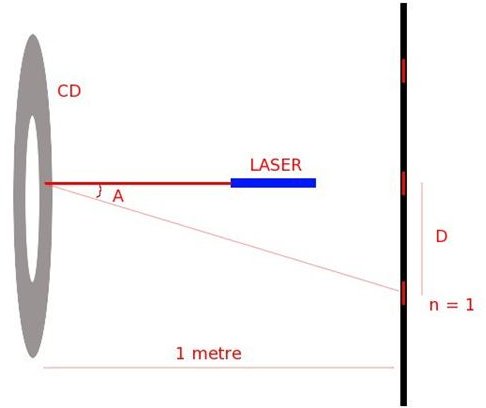Diffraction Experiment: Measure the Spacing of Grooves on a CD
Diffraction
Diffraction is a process that a wave undergoes when it encounters an obstacle with size of the order of its wavelength. This involves the redistribution of energy contained in light waves by the principle of superposition. This results in bright and dark fringes on a projection screen. The spacing between these fringes depends on the size of the obstruction and the wavelength used.
The precision of this process is such that it is used to measure the lattice structure dimensions of crystals. Here, we will try to use this process with laser wavelength to measure the spacing of grooves on CD. The formula for the groove spacing, d, is
d = nL/sin(An)
where
n = fringe number starting with 0 as the central fringe
L = wavelength of light used
An = angle between the incident light and the diffracted beam forming the nth fringe.
Requirements
The requirements of this experiment are very basic. This can easily be carried out inside the classroom.
1. A table.
2. A CD or DVD (preferably blank)
3. A laser pointer with known wavelength. The wavelength is generally written on the pointer. The inexpensive red lasers are around 670 nm.
4. A ruler or meter scale.
5. A screen. However, the classroom wall can also be used as a screen.
Setup
In the adjacent figure, the schematic setup of the experiment is shown.
1. Place the CD vertically facing the screen and 1 meter away from it. The readable part of the CD (non-labeled part) should be toward the screen.
2. Fix the laser between the screen and the CD such that light from it incidents directly onto the CD.
3. Switch on the laser. Adjust the screen such that you see the fringes on it.
Observations and Calculations
Once the fringes are produced, the distance between the central fringe and the first fringe on one side of it should be measured. Let us call this distance D (in meters). This distance must be measured in order to calculate the angle A.
From the figure,
tan (A) = D
=> A = tan-1(D)
Now, the groove spacing ’d’ can be easily calculated using
d = L/sin(A) for n=1
Sample Results
Using a laser of wavelength(L) 650 nm, the following results are obtained.
D = 40 cm = 0.4 metres
=> A = tan-1(D) = 21.8 degrees
d = L/sin(A) = 650/sin(21.8) = 1750 nm which is very close to the actual spacing.
